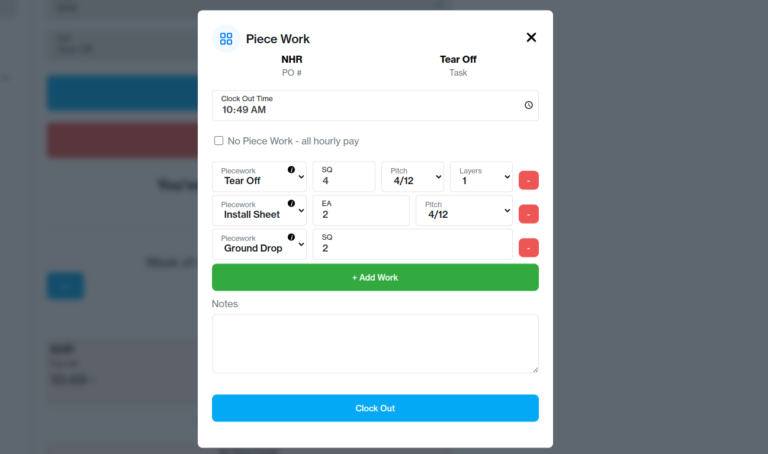Debunking 5 Myths About Piece Work
Table of Contents
- Introduction
- Myth #1: “Piece Work Is Unfair to Workers”
- Myth #2: “Piece Work Leads to Poor Quality and Rushing”
- Myth #3: “Tracking Piece Work Is Too Complicated”
- Myth #4: “Workers Won’t Accept a Piece Rate System”
- Myth #5: “Piece Work Isn’t Legal or Compliant”
- Conclusion
Introduction
Piece work is a way of paying employees based on how many units or tasks they complete. In roofing, for example, a unit might be a square of shingles installed. Other companies may use a “piece” to mean a room cleaned or a set of parts assembled. People often have strong opinions about paying by the piece. Some say it is unfair, others worry about quality, and a few think it is impossible to manage.
These concerns can seem overwhelming, but many of them are built on myths or misunderstandings. In reality, a piece work system can boost productivity, simplify job costing, and give employees more control over their earnings. This article looks at five common myths about piece work and explains why they might not be true.
We will also see how the right approach can handle these worries. Tools like easy clock-in/clock-out apps and daily piece entry systems can solve many tracking problems. Quality checks and fair rules make sure workers feel safe and rewarded. By the end, you will have a clearer sense of whether piece work might fit your business.
Myth #1: “Piece Work Is Unfair to Workers”
Some people say piece work only benefits employers, leaving workers underpaid. This myth comes from stories about low piece rates or tasks that seem impossible to finish. While it is true that a poorly designed piece rate system can cause problems, a fair piece work plan treats employees more equitably than you might expect.
Why It Is a Myth
- Clear Links Between Work and Pay: In a good piece work system, every completed unit has a set value. If employees produce more or do tasks faster, they earn more. This can give high-performing workers a sense of control.
- Choice of Pay Structures: Businesses often customize piece work systems to fit real conditions. They might pay purely by the piece for certain tasks or mix it with hourly pay for complicated jobs. This flexibility protects workers and ensures everyone gets credit for tasks that are not easy to measure by piece.
How to Keep It Fair
- Base Rates on Real Data: Observe how long it takes an average worker to finish a piece. Turn that time into a rate that is close to what a fair hourly wage would be.
- Revisit Rates Often: Check if employees earn about the same as they did under an hourly model (or better). If rates are too low, adjust them.
- Rotate Tough Tasks: In roofing or other industries, some tasks might be harder than others. Rotate them among workers or assign higher piece rates for complex work.
When a piece rate plan comes from real numbers and includes fair rules, workers see the benefits instead of feeling cheated.
Myth #2: “Piece Work Leads to Poor Quality and Rushing”
Another myth claims that piece work causes workers to rush, leading to sloppy results. This is a valid concern if quality checks do not exist. In some cases, people may hurry too much, skip steps, or cut corners. However, tying payment to quality can prevent these problems.
Why It Is a Myth
- Quality Controls: Many companies enforce clear standards. For roofing, that might mean using the proper number of nails per shingle or installing flashing the right way. If these steps are missed, the piece is not counted until it is fixed.
- Team Accountability: In a healthy crew environment, other workers will speak up if someone skips important steps. Poor work can delay the entire job and affect everyone’s pay, which encourages the team to keep each other in check.
How to Maintain Quality
- Spot Checks: Regular inspections catch mistakes early. They also teach new crew members what a finished piece should look like.
- Set Clear Standards: Write out what must be done for a piece to count. If a piece fails inspection, the worker fixes it before it is accepted. This helps workers learn the right way from day one.
- Reward Safety and Care: Some companies add small bonuses or praise for zero rework or a perfect safety record. Workers then see that speed is only part of the overall picture.
When managers mix piece work with strong quality rules, employees learn that rushing without care will not pay off in the long run.
Myth #3: “Tracking Piece Work Is Too Complicated”
People sometimes think piece work involves endless paperwork. They imagine workers writing down daily tallies on slips of paper that get lost or mixed up. They worry about spending hours on payroll or fighting over who installed which square. This fear keeps many from even exploring the idea of a piece rate system.
Why It Is a Myth
- Modern Tools: Digital solutions like Piece Work Pro allow each worker to clock in and out with a tap. They can also enter how many pieces they finished that day. This data flows into one system, so managers no longer need to juggle spreadsheets.
- Built-In Alerts: Some systems flag unusual data. For example, if a worker claims an impossible number of pieces or forgets to log any work, the software alerts the manager to double-check.
Making Tracking Easier
- Embrace Technology: Look for apps or web platforms that track hours and pieces in the same place. Approving time cards should be as simple as clicking a button.
- Daily Entries: Encourage the crew to enter piece totals at the end of each day. This reduces memory errors and helps everyone stay accountable.
- One-Click Payroll Reports: Good software can produce payroll summaries in minutes. These include each person’s total hours, total pieces, and final pay.
Thanks to modern tools, piece work can be simpler to manage than older methods of logging time sheets by hand.
Myth #4: “Workers Won’t Accept a Piece Rate System”
Many managers worry that employees will resist piece work. Some fear a backlash when switching from hourly pay. Others think that new hires will not be interested. While change can be stressful, it is not always the case that workers dislike piece rate. In fact, many high performers prefer it because it rewards skill and effort right away.
Why It Is a Myth
- Earnings Potential: People who work efficiently can earn more on piece rate than they would from an hourly wage. They do not have to wait for annual raises if they are producing extra value each day.
- Fairness: A well-planned system shows each worker exactly how their pay is calculated. This level of clarity can build trust.
- Feedback and Training: If employees have trouble meeting goals, managers can step in to offer coaching or adjust rates. This approach helps workers feel supported rather than abandoned.
Winning Over the Team
- Explain the Benefits: Show how piece work can lead to higher pay for strong workers. Offer a short trial period so they see real results.
- Provide Resources: Train employees on how to track pieces and how to maintain quality. Make sure they know who to ask if they have questions.
- Stay Open to Feedback: Gather input regularly. If the crew says certain tasks take too long, consider adjusting the rate or giving them better tools to speed up.
Workers are more likely to accept piece rate if they see it as a fair chance to earn more while still doing safe, high-quality work.
Myth #5: “Piece Work Isn’t Legal or Compliant”
Some people assume piece work breaks labor laws. They think employees will not meet minimum wage requirements or will miss out on overtime pay. While it is true that employers must follow certain guidelines, piece work itself is legal in many places if done correctly.
Why It Is a Myth
- Labor Laws Allow It: Most labor laws do not forbid piece rate pay. They often require tracking hours to ensure workers make at least the minimum wage. This means a business must pay the difference if an employee’s piece rate total falls below that level.
- Overtime Still Applies: Even in a piece rate system, overtime rules usually remain in place. If someone works more than 40 hours in a week (in many areas), the company calculates overtime based on average pay rates.
- Accurate Records: The key to compliance is keeping detailed records of hours worked and pieces completed. Modern software makes it easier to prove that workers received the correct pay.
Steps to Stay Compliant
- Track Hours and Pieces: Never skip hour tracking, even if your main pay method is piece rate.
- Meet or Exceed Minimum Wage: Check each employee’s total pay. If they fall below the legal minimum for the hours worked, top up their pay.
- Understand Local Rules: Different regions have different laws on overtime and rest breaks. Make sure your system covers each requirement.
When businesses follow these steps, they can use piece work while still paying employees lawfully and fairly.
Conclusion
Piece work has inspired many questions and concerns. People often worry about fairness, quality, complicated tracking, worker acceptance, and legal rules. Yet these fears usually come from outdated or incomplete information. In reality, a piece rate system can create a direct link between effort and pay, encourage better quality, and make job costing simpler.
Modern tools allow workers to clock in through an easy system, enter their piece work counts daily, and trust that their pay will be correct. Managers can then approve time cards, run quick payroll reports, and see which tasks cost the most per job. Over time, a piece work plan that includes fair rates, quality checks, and consistent communication can boost productivity and build team trust.
While every business is different, these five myths do not have to block the path to a more efficient pay model. By focusing on fairness, safety, and clear tracking, companies can thrive under a piece work system. It is worth exploring whether this approach fits your operations, especially if you want to reward hard work and get real data on how each job is completed. When done right, piece work often proves to be a win for everyone involved.




